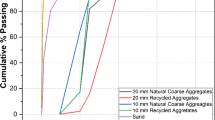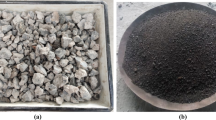Abstract
Enormous industrialization and urbanization have led to the generation of huge quantity of C&D waste, which requires its appropriate utilization or disposal. Keeping these in eyes, construction sector is focusing on sustainable waste management regulations nowadays. Thus, the sustainable future green cities can be possible only by using low-carbon resources, eco-friendly materials and through energy conservation techniques. The goal of this study was to evaluate the durability and in situ performances of concrete made with recycled coarse aggregate (RCA) using fluorogypsum as cementitious binder to replace the cement partially (25%). This leads to a new perspective for achieving green concrete. The quality of RCA and the influence of the replacement ratio were assessed on several parameters such as chloride ion penetration, carbonation and water absorption resistance. The in situ parameters such as ultrasonic pulse velocity (UPV) and rebound hammer number reflected the same behaviour with replacement percentage level of RCA. The UPV values of more than 3600 m/s, showed good-quality concrete. Though, RCA is having potentially inferior quality than natural aggregate (NA), it could be used to produce a structural grade concrete of strength more than 40 MPa. The results with fluorogypsum binder (FB) revealed that though it is having its own binder property, it could not achieve strength up to that with cement replacement. Rather, it can be used as a filling material or as an additive to improve its performance by making its matrix denser.
Access this chapter
Tax calculation will be finalised at checkout
Purchases are for personal use only
Similar content being viewed by others
References
Maullick, A. K. (2016). Viable alternatives to natural fine and coarse aggregate in concrete. In Proceedings of International Seminar on Emerging Building Materials and Construction Technologies, March 2016, New Delhi.
Malhotra, V. M., & Mehta, P. K. (2008). High performance high-volume fly ash concrete for building sustainable and durable structures (3rd ed.). Supplementary Cementing Materials for Sustainable Developments, Ottawa.
Etxeberria, M., Vázquez, E., Marí, A., & Barra, M. (2007). Influence of amount of recycled coarse aggregates and production process on properties of recycled aggregate concrete. Cement and Concrete Research, 37(5), 735–742.
Behera, M., Bhattacharyya, S. K., Minocha, A. K., Deoliya, R., & Maiti, S. (2014). Recycled aggregate from C&D waste & its use in concrete—A breakthrough towards sustainability in construction sector: A review. Construction and Building Materials, 68, 501–516.
Nixon, P. (1978). Recycled concrete as an aggregate for concrete-a review. Materials and Structures, 11(5), 371–378.
Hansen, T. C., & Narud, H. (1993). Strength of recycled concrete made from crushed concrete coarse aggregate. Concrete International, 5(1), 79–83.
Sagoe-Crentsil, K. K., Brown, T., & Taylor, A. H. (2001). Performance of concrete made with commercially produced coarse recycled concrete aggregate. Cement and Concrete Research, 31(5), 707–712.
Hansen, T. C. (1996). RILEM REPORT 6. Recycling of demolished concrete and masonry. Bodmin, UK: E&FN Spon1996.
Dhir, R. K., & Jappy, T. G. (Eds.). (1999). Proceedings of the International Conference on Exploiting Wastes in Concrete. UK: Thomas Telford.
Olorunsogo, F. T., & Padayachee, N. (2002). Performance of recycled aggregate concrete monitored by durability indexes. Cement and Concrete Research, 32(2), 179–185.
Cui, Z. L., Yang, L. H., & Ohaga, Y. (2006). Durability test investigation on the recycled aggregate concrete. Science Technology and Engineering, 6(21), 3516–3519.
Levy, S. M., & Helene, P. (2004). Durability of recycled aggregates concrete: A safe way to sustainable development. Cement and Concrete Research, 34(11), 1975–1980.
Otsuki, N., Miyazato, S., & Yodsudjai, W. (2003). Influence of recycled aggregate on interfacial transition zone, strength, chloride penetration and carbonation. Journal of Materials in Civil Engineering, 15(5), 443–451.
Kou, S. C., & Poon, C. S. (2012). Enhancing the durability properties of concrete prepared with coarse recycled aggregate. Construction and Building Materials, 35, 69–76.
Singh, M., & Garg, M. (1999). Cementitious binder from fly ash and other industrial wastes. Cement and Concrete Research, 29(3), 309–314.
Tam, V. W. Y., Tam, C. M., & Wang, Y. (2007). Optimization on proportion for recycled aggregate in concrete using two-stage mixing approach. Construction and Building Materials, 21, 1928–1939.
ASTM C 642-06. (2002). Standard test method for density, absorption, and voids in hardened concrete. West Conshohocken, USA.
Author information
Authors and Affiliations
Corresponding author
Editor information
Editors and Affiliations
Rights and permissions
Copyright information
© 2019 Springer Nature Singapore Pte Ltd.
About this paper
Cite this paper
Behera, M., Minocha, A.K., Bhattacharyya, S.K., Deoliya, R. (2019). Durability and In Situ Performance Evaluation of Sustainable Recycled Aggregate Concrete Using Fluorogypsum as Cementitious Binder. In: Rao, A., Ramanjaneyulu, K. (eds) Recent Advances in Structural Engineering, Volume 1. Lecture Notes in Civil Engineering , vol 11. Springer, Singapore. https://doi.org/10.1007/978-981-13-0362-3_78
Download citation
DOI: https://doi.org/10.1007/978-981-13-0362-3_78
Published:
Publisher Name: Springer, Singapore
Print ISBN: 978-981-13-0361-6
Online ISBN: 978-981-13-0362-3
eBook Packages: EngineeringEngineering (R0)




